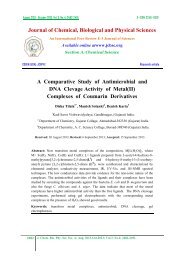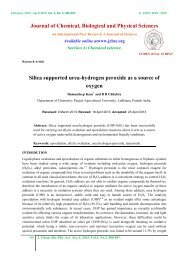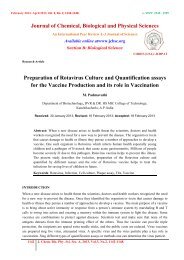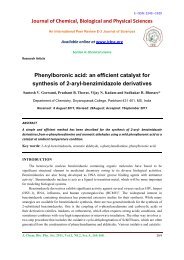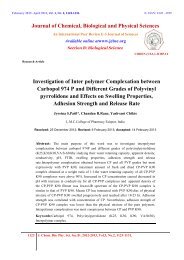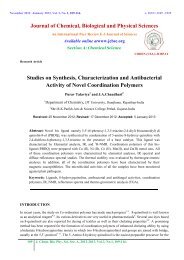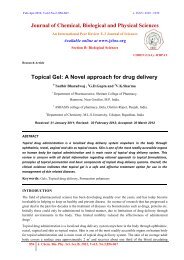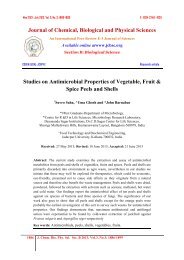Effect of different in situ water harvesting techniques and low cost ...
Effect of different in situ water harvesting techniques and low cost ...
Effect of different in situ water harvesting techniques and low cost ...
Create successful ePaper yourself
Turn your PDF publications into a flip-book with our unique Google optimized e-Paper software.
<strong>Effect</strong>…N. D. Polara et al.Andra Pradesh, Tamil Nadu, Orissa, Assam, Rjasthan, Maharashtra <strong>and</strong> Gujarat. The pleasant flavour <strong>and</strong>mild aroma have a universal acceptance as a table fruit. Moisture is the constra<strong>in</strong>t <strong>in</strong> commercial cultivation<strong>of</strong> arid horticultural crops. Hence, the need <strong>of</strong> the hours is to develop technologies which not only requires<strong>low</strong> <strong>water</strong> <strong>in</strong>put but also have high <strong>water</strong> use efficiency. Moisture be<strong>in</strong>g a rare commodity <strong>in</strong> arid ecosystem,the first <strong>and</strong> foremost requirement is to conserve the available soil or ra<strong>in</strong> <strong>water</strong>. For conservation <strong>of</strong> ra<strong>in</strong><strong>water</strong> both <strong>in</strong> <strong>situ</strong> <strong>and</strong> ex <strong>situ</strong> technologies have been developed 1 . Work done at Aruppukottai (Tamil Nadu)<strong>and</strong> Anantapur (Andhra Pradesh) has <strong>in</strong>dicated usefulness <strong>of</strong> <strong>in</strong> <strong>situ</strong> <strong>water</strong> harvest<strong>in</strong>g technique for fruitproduction 2 .Scarcity <strong>of</strong> irrigation <strong>water</strong> at critical periods <strong>of</strong> crop growth is a limit<strong>in</strong>g factors for successful cultivation <strong>of</strong>this crop <strong>in</strong> the arid <strong>and</strong> semi-arid region <strong>of</strong> Gujarat. Therefore, soil moisture conservation will def<strong>in</strong>itelyhelp <strong>in</strong> augment<strong>in</strong>g production. In <strong>situ</strong> <strong>water</strong> harvest<strong>in</strong>g <strong>and</strong> mulch<strong>in</strong>g <strong>in</strong>fluences the soil moisture, soiltemperature, suppress weed growth <strong>and</strong> ma<strong>in</strong>ta<strong>in</strong>s soil fertility. The present <strong>in</strong>vestigation was therefore,undertaken to assess the effect <strong>of</strong> <strong>in</strong> <strong>situ</strong> <strong>water</strong> harvest<strong>in</strong>g <strong>techniques</strong> <strong>and</strong> mulch<strong>in</strong>g on growth <strong>and</strong> yield <strong>of</strong>custard apple.MATERIALS AND METHODSThe present study conducted for most suitable <strong>in</strong> <strong>situ</strong> <strong>water</strong> harvest<strong>in</strong>g <strong>techniques</strong> <strong>and</strong> locally availablemulch<strong>in</strong>g materials <strong>in</strong> 5 years old custard apple cv. S<strong>in</strong>dhan local plant planted at 4 m x 4 m on ten farmer'sfield <strong>of</strong> Junagadh district <strong>in</strong> R<strong>and</strong>omized Block Design dur<strong>in</strong>g three consecutive years. Treatments wereapplied before ra<strong>in</strong>y season. The treatments consist<strong>in</strong>g <strong>of</strong> Control (without mulch<strong>in</strong>g) (T 1 ), Circular bas<strong>in</strong>with 5 per cent slope (T 2 ), Crescent bund<strong>in</strong>g across the nature slope <strong>of</strong> field (T 3 ) <strong>and</strong> Circular bas<strong>in</strong> with 5per cent slope <strong>and</strong> mulch<strong>in</strong>g with locally available organic materials (T 4 ). Recommended dose <strong>of</strong> fertilizerfor custard apple was applied <strong>in</strong> each year i.e. FYM 10 kg plant -1 + 200 N g plant -1 + 100 P 2 O 5 g plant -1 +200 K 2 O g plant -1 . Full dose <strong>of</strong> FYM, P 2 O 5 , K 2 O <strong>and</strong> half dose <strong>of</strong> N were applied with onset <strong>of</strong> monsoon <strong>and</strong>rema<strong>in</strong><strong>in</strong>g half dose <strong>of</strong> N was applied dur<strong>in</strong>g fruit development stage. Initial <strong>and</strong> after harvest soil analysiswas carried out to know the status <strong>of</strong> soil chemical parameters like pH, EC, O.C., available N, P 2 O 5 <strong>and</strong> K 2 O.Observation on growth parameters, fruit quality, fruit yield <strong>and</strong> soil moisture content at <strong>different</strong> soil depthfrom October to March <strong>in</strong> all the year was carried out <strong>and</strong> analyzed statistically.RESULTS AND DISCUSSIONThe <strong>different</strong> <strong>in</strong> <strong>situ</strong> <strong>water</strong> harvest<strong>in</strong>g <strong>techniques</strong> <strong>and</strong> mulch<strong>in</strong>g with locally available materials were foundsignificant for <strong>in</strong>fluenc<strong>in</strong>g the vegetative parameters <strong>of</strong> custard apple <strong>in</strong> three year pooled analysis dataexcept stem girth (Table 1). Treatment <strong>of</strong> circular bas<strong>in</strong> with 5 per cent slope <strong>and</strong> mulch<strong>in</strong>g with locallyavailable materials produced maximum height (3.27 m) which was at par with treatment crescent bund<strong>in</strong>g(3.14 cm). The same treatment also produced significantly highest plant spread <strong>in</strong> N-S <strong>and</strong> E-W direction.Fruit length (7.21 cm), fruit breathe (7.87 cm) <strong>and</strong> fruit weight (110.97 g) was found significantly highest <strong>in</strong>T 4 treatment, which was at par with T 3 treatment whereas fruit yield (16.08 kg plant -1 ) was significantlyhighest <strong>in</strong> T 4 treatment as compared to other treatments. Increased <strong>in</strong> fruit qualities <strong>and</strong> yield was might bedue to <strong>in</strong> <strong>situ</strong> <strong>water</strong> harvest<strong>in</strong>g <strong>techniques</strong> <strong>and</strong> mulch<strong>in</strong>g <strong>in</strong> general, helped <strong>in</strong> conserv<strong>in</strong>g soil moisture byreduction <strong>of</strong> evaporation loss <strong>of</strong> <strong>water</strong> from the soil <strong>and</strong> more absorption <strong>of</strong> nutrients by plant.1608 J. Chem. Bio. Phy. Sci. Sec. D, 2013, Vol.3, No.2, 1607-1612
<strong>Effect</strong>… N. D. Polara et al.Table 1: <strong>Effect</strong> <strong>of</strong> <strong>in</strong> <strong>situ</strong> <strong>water</strong> harvest<strong>in</strong>g <strong>and</strong> mulch<strong>in</strong>g on growth <strong>and</strong> yield <strong>of</strong> custard appleTreatments Plant height Stem girth Plant spread (m) Fruit weight (g) Fruit size (cm) Fruit yield(m)(cm)N-S E-W Length Breath (kg/plant)Control 2.91 20.95 2.47 2.41 105.76 6.55 7.28 14.62Circular bas<strong>in</strong> 2.92 21.06 2.59 2.49 107.28 6.69 7.43 14.85with 5 %Crescent bund<strong>in</strong>g 3.03 21.14 2.59 2.64 110.17 6.90 7.75 15.49Circular bas<strong>in</strong> 3.15 21.97 2.71 2.69 110.97 7.21 7.87 16.08with 5 % slop<strong>and</strong> locallyavailable mulchS.Em.± 0.05 0.31 0.05 0.05 1.57 0.13 0.15 0.31CD at 5 % 0.15 NS 0.15 0.15 4.59 0.36 0.41 0.89CV % 7.85 6.46 8.71 10.00 6.58 8.45 8.60 9.431609 J. Chem. Bio. Phy. Sci. Sec. C,2013, Vol.3, No.2, 1607-1612.
<strong>Effect</strong>...N.D.Polara et al.It also adds organic matter <strong>in</strong> soil by decay<strong>in</strong>g <strong>of</strong> organic mulches <strong>and</strong> improves soil biological activities.Our f<strong>in</strong>d<strong>in</strong>g had close conformity with f<strong>in</strong>d<strong>in</strong>gs <strong>of</strong> Gupta 3 .In <strong>situ</strong> <strong>water</strong> harvest<strong>in</strong>g treatment <strong>and</strong> mulch<strong>in</strong>g resulted <strong>in</strong> better moisture retention <strong>and</strong> causedimprovement <strong>in</strong> plant microclimate result<strong>in</strong>g <strong>in</strong> better vegetative growth <strong>and</strong> produced higher yield <strong>of</strong> bigsize fruits as compared to other treatmentsPareek 1 have reported that micro-catchment slopes greater than 5 per cent did not significantly affectrun<strong>of</strong>f at Jodhpur <strong>and</strong> that the highest ber yield were obta<strong>in</strong>ed when 0.5 per cent slopes had 8.5 m <strong>and</strong> 7m length <strong>of</strong> run <strong>and</strong> 72 m 2 <strong>and</strong> 54 m 2 catchment area per tree, respectively. Increase <strong>in</strong> fruit yield <strong>in</strong>custard apple with straw mulch also reported by M<strong>and</strong>al <strong>and</strong> Chattopadhyay 4 <strong>and</strong> Keskar et. al. 5 .Maximum TSS (24.85 ºBrix), reduc<strong>in</strong>g sugar (16.69 %) <strong>and</strong> total sugar (17.91 %) were recorded undertreatment T 4 while ascorbic acid content was not significantly affected due to <strong>different</strong> treatments(Table 2). Treatment T 4 recorded highest N content (225.68 kg ha -1 ) <strong>and</strong> P 2 O 5 content (25.98 kg ha -1 ).Potash content was not significantly affected by <strong>different</strong> treatments (Table 3). Electrical conductivity,pH, <strong>and</strong> organic carbon were not affected due to various treatments.Table 2: <strong>Effect</strong> <strong>of</strong> <strong>in</strong> <strong>situ</strong> <strong>water</strong> harvest<strong>in</strong>g <strong>and</strong> mulch<strong>in</strong>g on fruit quality <strong>in</strong> custard appleTreatments TSS (ºBrix) Reduc<strong>in</strong>g sugar(%)Total sugar (%)Control 23.80 15.91 17.21 35.69Circular bas<strong>in</strong> with 5 % 24.33 16.05 17.60 35.96Crescent bund<strong>in</strong>g 24.81 16.15 17.66 35.96Circular bas<strong>in</strong> with 5 %slop <strong>and</strong> locally availablemulch24.85 16.69 17.91 36.36S.Em.± 0.27 0.19 0.20 0.65CD at 5 % 0.77 0.53 0.58 NSCV % 5.13 5.26 7.29 8.32Ascorbic acid(mg/100 g pulp)Soil moisture content dur<strong>in</strong>g <strong>different</strong> period recorded from <strong>different</strong> soil depths as <strong>in</strong>fluenced by<strong>different</strong> treatments are presented <strong>in</strong> Table 4. The data recorded on soil moisture at <strong>different</strong> depth <strong>of</strong> soil<strong>in</strong>dicted that the content <strong>of</strong> soil moisture had <strong>in</strong>creas<strong>in</strong>g trend as per <strong>in</strong>crease <strong>in</strong> soil depth. There wasdepletion <strong>of</strong> the soil moisture as advancement <strong>of</strong> season (i.e. it was highest <strong>in</strong> the month <strong>of</strong> October <strong>and</strong><strong>low</strong>est <strong>in</strong> the month <strong>of</strong> March) Treatment circular bas<strong>in</strong> with 5 % slope <strong>and</strong> locally available mulchconserve more soil moisture percentage. Increased <strong>in</strong> soil moisture content with circular bas<strong>in</strong> with 5 %slope <strong>and</strong> locally available mulch might be due to the <strong>in</strong>creased <strong>in</strong> <strong>in</strong>filtration <strong>and</strong> percolation rate <strong>of</strong> soil<strong>and</strong> ow<strong>in</strong>g to resistance <strong>of</strong> run<strong>of</strong>f <strong>water</strong> <strong>and</strong> also mulch<strong>in</strong>g might have reduced the rate <strong>of</strong> evaporation <strong>of</strong>soil moisture from soil surface, thus reta<strong>in</strong><strong>in</strong>g the soil moisture <strong>in</strong> the soil for longer time. Similar resultswere also reported by Chovatia et. al. 6 <strong>in</strong> ber under dryl<strong>and</strong> condition.1610 J. Chem. Bio. Phy. Sci. Sec.C, 2013, Vol.3, No.2, 1607-1612.
<strong>Effect</strong>…N. D. Polara et al.Table 3: <strong>Effect</strong> <strong>of</strong> <strong>in</strong> <strong>situ</strong> <strong>water</strong> harvest<strong>in</strong>g <strong>and</strong> mulch<strong>in</strong>g on available nutrients <strong>in</strong> custard appleTreatmentspH 2.5 EC (mmhoscm -2 )O.C.(%)AvailableN(kg ha -1 )AvailableP 2 O 5(kg ha -1 )AvailableK 2 O(kg ha -1 )Control 8.13 0.348 0.535 215.44 24.31 336.10Circular bas<strong>in</strong> with 5 % 8.07 0.336 0.541 220.46 25.66 344.43Crescent bund<strong>in</strong>g 8.05 0.330 0.534 221.74 25.14 337.89Circular bas<strong>in</strong> with 5 % slop<strong>and</strong> locally available mulch8.01 0.335 0.548 225.68 25.98 340.90S.Em.± 0.10 0.009 0.01 3.15 0.41 4.27CD at 5 % NS NS NS 8.67 1.15 NSCV % 4.52 6.76 5.50 6.30 7.35 5.73Table 4: Average soil moisture content (%) under <strong>in</strong> <strong>situ</strong> <strong>water</strong> harvest<strong>in</strong>g <strong>and</strong> mulch<strong>in</strong>gtreatments <strong>in</strong> custard apple at vary<strong>in</strong>g soil depthTreatments October November20 cm 40 cm 60 cm 20 cm 40 cm 60 cmControl 18.0 18.8 19.0 14.0 16.1 17.3Circular bas<strong>in</strong> with 5 % 18.8 19.4 19.0 14.4 16.1 17.3Crescent bund<strong>in</strong>g 18.7 19.4 19.0 14.2 16.0 17.5Circular bas<strong>in</strong> with 5 % slop<strong>and</strong> locally available mulch19.5 20.1 20.9 15.7 17.4 18.9DecemberJanuaryControl 11.0 12.7 13.3 07.2 11.1 12.0Circular bas<strong>in</strong> with 5 % 11.4 14.5 15.4 07.4 11.7 13.3Crescent bund<strong>in</strong>g 11.3 14.5 15.5 07.7 11.8 13.2Circular bas<strong>in</strong> with 5 % slop<strong>and</strong> locally available mulch11.7 14.8 16.2 08.4 12.5 14.0FebruaryMarchControl 05.7 08.1 09.8 04.7 07.1 08.7Circular bas<strong>in</strong> with 5 % 06.6 09.5 10.7 05.6 08.2 09.3Crescent bund<strong>in</strong>g 06.6 09.4 10.8 05.7 08.2 09.4Circular bas<strong>in</strong> with 5 % slop<strong>and</strong> locally available mulch07.2 11.0 11.6 06.0 10.0 10.51611 J. Chem. Bio. Phy. Sci. Sec. C,2013, Vol.3, No.2, 1607-1612.
<strong>Effect</strong>…N. D. Polara et al.REFERENCES1. O.P.Pareek, Irrigation management <strong>in</strong> fruit crops. In S<strong>in</strong>gh, D.P. <strong>and</strong> Sharma, H.C. (eds.) ImportantAspect <strong>of</strong> on farm <strong>water</strong> management. CCS HAU, Hisar,1993.2. Anonymous, Proc. <strong>of</strong> 5 th National Workshop on Arid Zone Fruit Research, GAU, Sardarkrush<strong>in</strong>agar,July 6-9, 1989. Tech. Doc. No. 27, Hisar, India: Coord<strong>in</strong>ation Cell, AICRP on Arid Zone Fruits,ICAR,1989,3. J.P.Gupta, Water losses <strong>and</strong> their control <strong>in</strong> ra<strong>in</strong>fed agriculture. In: S<strong>in</strong>gh, R.P. (ed.) Susta<strong>in</strong>ableDevelopment <strong>of</strong> Dryl<strong>and</strong> Agriculture <strong>in</strong> India. Jodhpur, India: Scientific Publishers, 1995, 169-176.4. A.M<strong>and</strong>al. <strong>and</strong> P.K.Chattopadhyay, Growth <strong>and</strong> yield <strong>of</strong> custard apple as <strong>in</strong>fluenced by soil cover.Indian J Hort,1994, 51(2): 146-49.5. B.G. Keskar, D.P. Bhore, <strong>and</strong> S.R.masalekar, <strong>Effect</strong> <strong>of</strong> NAA <strong>and</strong> mulch on yield <strong>of</strong> custard apple.J Maharashtra agric Univ.1986, 11: 235-36.6. R.S.Chovatia, D.S. Patel, G.V. Patel, <strong>and</strong> N.K.Kalyana Sundaram, <strong>Effect</strong>iveness <strong>of</strong> mulches on ber(Zizyphus mauritiana L.) cv. Umran under dryl<strong>and</strong> conditions. Annals <strong>of</strong> Arid Zone 1992,31(4): 301-02.Correspond<strong>in</strong>g author: Dr. N. Joshi, Subject Matter Specialist, Krishi Vigyan Kendra, JunagadhAgricultural University, Amreli-365601 (Gujarat)1612 J. Chem. Bio. Phy. Sci. Sec.C, 2013, Vol.3, No.2, 1607-1612.



